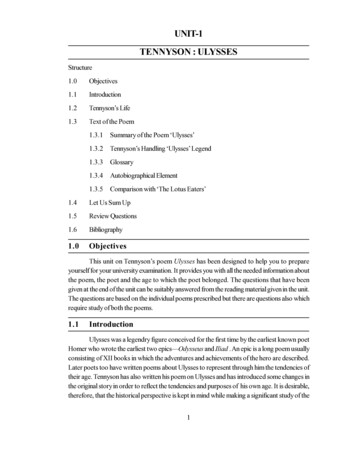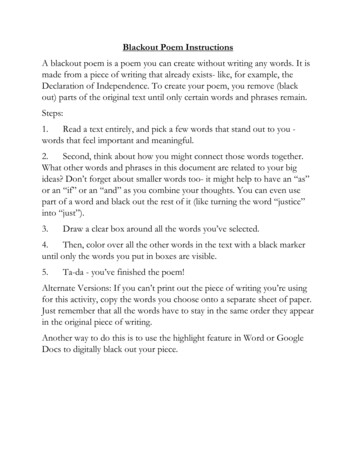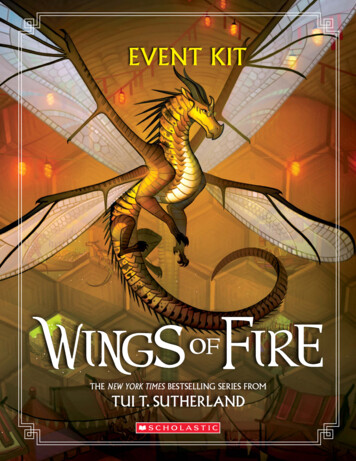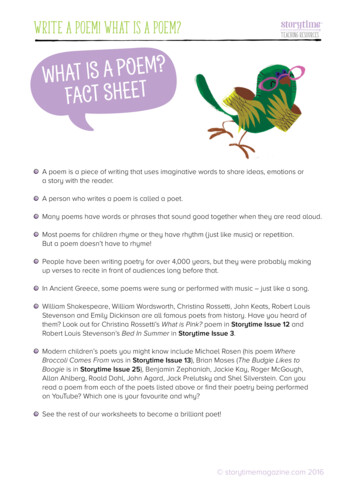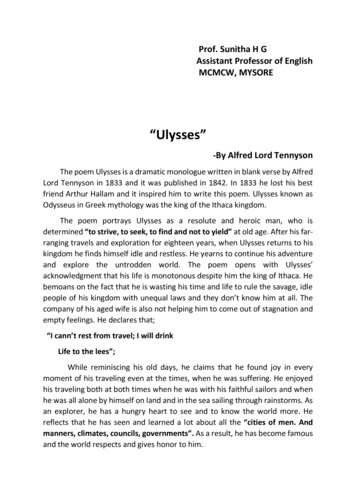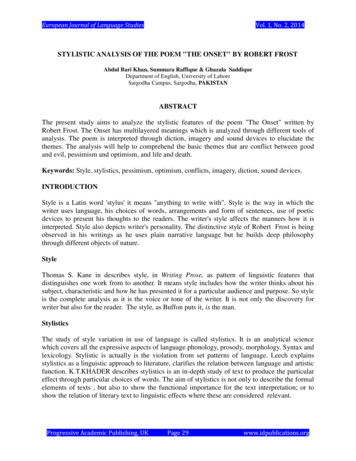
Transcription
CAP Activity Planning Template(6th grade Language Arts)What is the new knowledge? Specific learning objective?Students will read poetry and use content and context to make inferences. They willdemonstrate knowledge and understanding of poetic devices and will havediscussions about published poetry (in this assignment, students read JackPrelutsky’s “There’s a New Kid on the Block”).What kind of elevated thinking do I want my students doing? (from Kaplan)Circle yourchoices Language of theDiscipline Details RulesTrendsUnansweredQuestionsAcross theDisciplinesEthics PatternsChanges over TimeBig Ideas MultiplePerspectivesThe TASKS:TypeCAPActivity (highlight, underline, bold, etc., the common expectation)Read the poem. Then search for and identify poetic devices(rhyme scheme, rhythm, sound devices, alliteration, repetition,verse, speaker, voice, diction). Then, imagine you are the new kidthat was written about in this poem. Write a new poem following thesame patterns and form as the new kid. How did the new kid feel?Why was she behaving badly? How could the speaker have helped?Read the poem. Then search for and identify poetic devices(rhyme scheme, rhythm, sound devices, alliteration, repetition,verse, speaker, voice, diction). What role do these sound devicesplay in how the reader interprets the poem? Why are they importantto identify and understand? How do you think the new kid felt? Makea chart that identifies the clue words in the poem about how thespeaker felt and how the new kid probably felt too. Post the chart forother students to view and discuss.Read the poem. Then search for and identify poetic devices(rhyme scheme, rhythm, sound devices, alliteration, repetition,verse, speaker, voice, diction). Consider all these devices and thetone in the poem. How would this poem be read and interpreteddifferently in the 1950s? More shocking? Funny? Relatable? How didthe new kid feel? Would this poem have worked if the new kid were aboy, as the reader probably predicted?Assessment/ Common Rubric:Poetic devices and terms used accurately in discussions and presentations, inferencesmade and justified about how the new kid felt
CAP Activity Planning Template(7th grade pre-algebra)What is the new knowledge? Specific learning objective?Students will be able to identify and explain the importance of each step in solving analgebraic equation.What kind of elevated thinking do I want my students doing? (from Kaplan)Circle yourchoices Language of theDisciplineDetails RulesTrendsUnansweredQuestions Across theDisciplinesEthics PatternsChanges over TimeBig IdeasMultiplePerspectivesThe TASKS:TypeActivity (highlight, underline, bold, etc., the common expectation)CStudents will work together to create a silent demonstration, utilizingsymbols and vocabulary for each step of solving an algebraicequation, to demonstrate clarity about the importance of this processto solving an equation accurately.AStudents will work in pairs to outline the sequence of actions takenwhen solving an algebraic equation. They will utilize symbols andvocabulary for each step of solving an algebraic equation todemonstrate clarity about the importance of this process. They willthen discuss which step seems the most significant and why.PStudents will work in pairs or small group to discuss the implicationsfor this process if any one step of solving an algebraic equation doesnot happen. The students will utilize symbols and vocabulary for eachstep of solving an algebraic equation to demonstrate clarity about theimportance of this process and the consequence of missing any step.Assessment/ Common Rubric:Demonstration of all required steps, quality of discussion and product uponpresentation
CAP Activity Planning Template(7th grade Science)What is the new knowledge? Specific learning objective?Students will understand the concepts of transcription and translation and will beable to articulate the functions of tRNA, mRNA, rRNA, DNA and their process roles asrelated to protein synthesis.What kind of elevated thinking do I want my students doing? (from Kaplan)Circle yourchoices Language of theDiscipline Details RulesTrendsUnansweredQuestionsAcross theDisciplinesEthicsPatternsChanges over Time Big IdeasMultiplePerspectivesThe TASKS:TypeCAPActivity (highlight, underline, bold, etc., the common expectation)Students will develop a skit to physically act out or become the stepsof protein synthesis. They will include a script that demonstrates theirfluency with the terms and process roles.Describe what happens during the steps of protein synthesis. Whichstep seems to be the most important or significant, and why? Discussthis ranking within your small group and share with class.Considering the steps of protein synthesis, describe what wouldhappen to the process if something (i.e. messenger RNA) weremissing or not working properly. Be prepared to share yourdiscussion results with the class.Assessment/ Common Rubric:Accurate use of terms, demonstration of process steps
CAP Activity Planning Template(8th grade Social Studies)What is the new knowledge? Specific learning objective?Students will discuss and understand the U.S. economy, society and politics in theyears following World War II. They will use terms associated with WWII (Cold War,communism, arms race, baby boom, assembly lines, segregation, genocide, vacuumcleaner, television, automobiles, labor camps).What kind of elevated thinking do I want my students doing? (from Kaplan)Circle yourchoices Language of theDiscipline Details RulesTrends UnansweredQuestionsAcross theDisciplines EthicsPatterns Changes overTime Big Ideas MultiplePerspectivesThe TASKS:TypeCAPActivity (highlight, underline, bold, etc., the common expectation)Students will examine new products released in the U.S. between1945 and 1950. They will examine the advertisements for theseproducts and will be able to articulate how these advertisementsinform us about American society at the time. Then, students willtake a real product from today and create an advertisement for it asthough the year is 1948.Students will examine new products released in the U.S. between1945 and 1950. They will examine the advertisements for theseproducts and will be able to articulate how these advertisementsinform us about American society at the time. Determine the traitseach of the advertisements you view has in common and why thesecommonalities might exist.Students will examine new products released in the U.S. between1945 and 1950. They will examine the advertisements for theseproducts and will be able to articulate how these advertisementsinform us about American society at the time. How would theseadvertisements be received by American audiences today? Whatsimilarities and differences can you identify between our society in1948 and modern day?Assessment/ Common Rubric:Accurate use of terms, productive collaboration, demonstration of how advertisementsinform us about society
CAP Activity Planning Template(9th grade World Geography)What is the new knowledge? Specific learning objective?Students will understand the physical geography of North America, including rivers,mountains, deserts, oceans, and will examine how humans impact the physical andecological processes that shape North America. They will use content terminology todiscuss the impact humans have on the physical world.What kind of elevated thinking do I want my students doing? (from Kaplan)Circle yourchoices Language of theDiscipline DetailsRulesTrendsUnansweredQuestionsAcross theDisciplines Ethics Patterns Changes overTimeBig Ideas MultiplePerspectivesThe TASKS:TypeActivity (highlight, underline, bold, etc., the common expectation)CThrough visual demonstration or through an original short story,small groups will demonstrate the impact humans have on thephysical world on the North American continent. Students will usecontent terms to demonstrate understanding as they share with theclass.ASmall groups will examine the impact humans have on the physicalworld on the North American continent and will rank these impactsfrom most to least significant on the physical world. They willarticulate these rankings to the class as they use content terms todemonstrate understanding.PSmall groups will consider the impact humans have on the physicalworld on the North American continent. They will then discuss whatthe physical state of the continent might be without certain types ofhuman impact (technology, waste, etc.). They will share their resultswith the class while using content terms to demonstrateunderstanding.Assessment/ Common Rubric:Content terminology used correctly, accuracy in impacts from humans on physicalworld, appropriate and effective collaboration
CAP Activity Planning Template(10th grade English)What is the new knowledge? Specific learning objective?Students will demonstrate the ability to read a non-fiction text and determine aposition in response to the text. They will utilize language from the rhetoricalsituation (ethos, logos, pathos; audience, author, topic, voice, purpose) and will thenbe prepared to begin prewriting for an essay of argument. Students will read, “IsGoogle Making us Stupid?” by Nicholas Carr, from the Atlantic, 2008.What kind of elevated thinking do I want my students doing? (from Kaplan)Circle yourchoices Language of theDiscipline DetailsRulesTrends UnansweredQuestions Across theDisciplinesEthicsPatternsChanges over Time Big IdeasMultiplePerspectivesThe TASKS:TypeCAPActivity (highlight, underline, bold, etc., the common expectation)Students will write and perform a skit demonstrating awareness ofthe rhetorical situation and the use of rhetoric in the reading. Theymay perform with or without dialogue but must narrate theperformance using content terminology to demonstrateunderstanding.Students will create an outline from the reading, emphasizing therhetorical situation and use of rhetoric in the text. They will thendiscuss and indicate which rhetorical element was the most effectiveand why. They will share their decision with the class and must usecontent terminology in that presentation to demonstrateunderstanding.Students will review the article they read searching for most and leasteffective rhetoric. They will then consider how the efficacy of the textmight have shifted without the use of each rhetorical element, orwithout consideration of the rhetorical situation. They will discussthese questions and present their ideas to the class using and will usecontent terminology to demonstrate understanding as they share.Assessment/ Common Rubric:Accurate terminology, rhetorical situation was correctly identified, elements ofrhetoric were cited and accurately articulated, effective collaboration in smallgroups, text evidence was appropriate
Rubric: CAP Activity 10th Grade EnglishElement ExpectedPointsPossibleAccurateTerminology:used and embeddedin critical response toarticle20Identification ofRhetoricalSituation:Speaker, audience,topic /purpose20Examples ofRhetoric CitedAccurately:appeals of ethos,pathos, logos20Appropriate andEffective TextEvidence:Examples are cleardemonstrations ofappeals and labeledaccuratelyProductive GroupCollaboration:All memberscontribute and addinsight toconversationsPoint Totals:20Additional Comments:20PointsAchievedTeacher Notes
CAP Activity Planning Template(11th grade Physics)What is the new knowledge? Specific learning objective?In the unit on kinematics, students will use vectors to represent position,displacement, velocity and acceleration. They will define scalar and vector quantityand will distinguish between: clock reading and time interval; distance, position anddisplacement; speed, velocity and acceleration; fixed frame of reference and movingframe of reference*lesson objective borrowed from Prince Edward Island Physics curriculum, 2009.What kind of elevated thinking do I want my students doing? (from Kaplan)Circle yourchoices Language of theDiscipline Details RulesTrends UnansweredQuestionsAcross theDisciplinesEthics PatternsChanges over Time Big IdeasMultiplePerspectivesThe TASKS:TypeCAPActivity (highlight, underline, bold, etc., the common expectation)Consider the properties in an ideal frictional setting for a professionalgolfer. Design that setting, and incorporate horizontal and velocityvectors, trajectory of the ball as it is stricken, golfer height and forceof gravity may also be indicated. Terms associated with vectorsshould be used accurately and consistently in labels.Consider the properties in an ideal frictional setting for a professionalgolfer. List these properties and then rank each item in terms ofimpact on the trajectory of the ball/accuracy of the shot. Consider avariety of elements that impact the ball and make a chart thatpresents your findings to the class. Terms associated with vectorsshould be used accurately and consistently in presentation.Consider the properties in an ideal frictional setting for a professionalgolfer. Examine each property and then make engineering decisionsthat will address or troubleshoot these elements that will have apotentially negative impact on the trajectory of the perfect shot. Howcan you improve performance by making these adjustments? Termsassociated with vectors should be used accurately andconsistently in this discussion and presentation.Assessment/ Common Rubric:Related terms to vectors used consistently and accurately, scenarios are explored fullyand problem-solving is displayed in small groups, productive collaboration
CAP Activity Planning Template(12th grade Calculus)What is the new knowledge? Specific learning objective?Students will demonstrate the ability to break up an integral into u and dv. They willbe able to articulate the distinctions between u and dv. They will consider I LATE toguide them in functions. (I inverse trigonometric functions L logarithmicfunctions A algebraic functions T trigonometric functions and E exponentialfunctions)Student objectives and sample equations borrowed from Josh Falb, lesson on Integration by Parts(pleacher.com)What kind of elevated thinking do I want my students doing? (from Kaplan)Circle yourchoices Language of theDiscipline Details RulesTrends UnansweredQuestions Across theDisciplinesEthics PatternsChanges over Time Big IdeasMultiplePerspectivesThe TASKS:TypeCActivity (highlight, underline, bold, etc., the common expectation)Using the examples on the support document, create a cartoon thatillustrates each integral as it is solved by Integration By Parts. Be asclever as you like, but be sure you are considering I LATE andarticulating the placements into u and dv for each example.AUsing the examples on the support document, apply the rules for ILATE to each example. Identify the reasons you would place for u andfor dv and the benefits to each placement. Be sure you areconsidering I LATE and articulating the placements into u and dvfor each example.PUsing the examples on the support document, discuss and analyze thereasons for each placement into u and dv. Then, design an equationthat would be an exception to these I LATE rules. Be sure you areconsidering I LATE and articulating the placements into u and dvfor each example.Assessment/ Common Rubric:Accurate application of I LATE to each equation on support document, accurateplacements of integrals into u and dv
Support Document: CAP CalculusExamples of Integrals that can be Solved by Integration By Partsò u dv u v - ò v du** isolate examples without responses to let students work throughintegrals. Then, present accurate responses at tend of activity. Offersupports as needed while they work through these tasks.*examples from Josh Falb, lesson on Integration by Parts (pleacher.com)
verse, speaker, voice, diction). Then, imagine you are the new kid that was written about in this poem. Write a new poem following the same patterns and form as the new kid. How did the new kid feel? Why was she behaving badly? How could the speaker have helped? Read the poem. Then search for and identify poetic devices A




